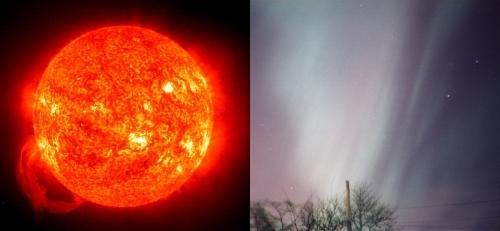 SkyCaramba astronomy blog for the week ending April 30, 2011
SkyCaramba astronomy blog for the week ending April 30, 2011
Another solar cycle is starting. That’s a period in which the number of sunspots and solar flares rises and falls. It averages close to 11 years. Over the last four centuries, the sun’s cycles have been as short as nine and as long as 14 years. When Galileo observed sunspots, nobody knew yet about solar flares or the connection between solar activity and auroras.
The sun’s been quiet the last few years. But in the last few months, the number of sunspots seen at one time has increased. Sunspots are relatively cool areas on the sun. They look dark because the brightness of any point on the sun’s disk is closely related to the temperature there.
Some sunspots are big enough to see without magnification. Some can be seen with binoculars. Many more can be seen with a telescope. In any case, never look at the sun without a filter made specifically for that purpose. Check with an astronomy shop for a filter you can hold in front of your eyes or that you can put on your binoculars or telescope.
Areas around sunspots are often sources of solar flares. In a solar flare, the sun throws off some of the stuff it’s made of. If the flare is strong enough and heading in the right direction, the solar particles hit the earth’s upper atmosphere causing it to glow in various hues. This phenomenon is called an aurora. In the northern hemisphere, it’s called the aurora borealis or northern lights. In the southern hemisphere, it’s called aurora australis or southern lights.
An aurora is a most mesmerizing and beautiful sight. People who live close to the equator don’t see it often, because solar particles are attracted to the earth’s magnetic poles. People who live far enough north or south can see aurorae practically any time the sky’s dark and clear.
When people began using electrical devices, aurorae weren’t just visible phenomena anymore. On a few occasions in the 1840s and 1850s, unexpected currents flowed through telegraph systems. Sometimes jumbled signals were printed. Sometimes telegraph paper caught fire! The operators realized it happened around the time of magnificent auroral displays. The most significant such event happened in 1859. Some telegraph operators disconnected their batteries and continued sending and receiving messages using only the current stimulated by the aurora.
The telegraph age is behind us, but solar flares can still disrupt our lives. An aurora in 1989 caused power outages in Quebec, while the sky glowed red as far south as Mexico. In 1998, a solar flare crippled a communications satellite used for ATMs, pagers, and credit card services.
It’s probably just a matter of time before another huge solar flare causes big problems on Earth. Fortunately, we know a lot more now about monitoring the sun and predicting when sheets of solar material are coming. We may be able to disconnect some of the really important equipment and put it back in use after only a day or two.